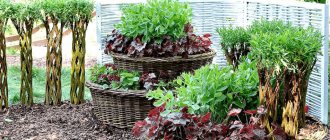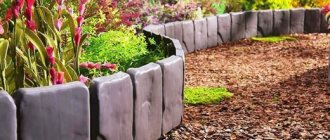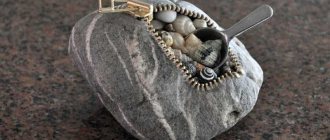DIY mill craft.
Good afternoon, dear readers! This post is dedicated to another DIY craft. And today we will learn how to make a toy mill with our own hands. Children of older preschool age already know how to take care of their creations, so it’s quite possible to entrust them with crafts made from paper and cardboard to play with. Our DIY mill craft is made from just these materials.
To make a mill craft we will need:
- thick cardboard, paper (white, you can use printer paper);
- a couple of unnecessary markers;
- skewers for kebabs (for making blades);
— watercolor paints (for painting the details of the toy mill);
DIY mill description:
1. Our mill toy has the shape of a cylinder, so first of all we glue the cardboard cylinder using PVA glue.
2. Cover the cylinder with white paper and glue it to the “ground” (a sheet of very thick cardboard from a box).
3. Paint the base of our mill craft with brown paint. This can be entrusted to a child even of a very young age. The paint that gets on the cardboard “ground” will then be covered with a white sheet. The child himself or with your help, after the brown paint has dried, paints the door and window.
4. In the middle of the white sheet (it should be larger in area than the cardboard ground), carefully cut out a circle whose diameter is equal to the diameter of the mill cylinder. Then we give this sheet to the child to color. In addition to green grass, he can draw flowers, paths, etc.
5. After drying, we put our “lawn” on the cylinder and glue it to the base soil, tucking the edges.
Now let's start making the roof of the mill craft with our own hands:
6. Glue a truncated cone from cardboard, glue a cone of white paper on top, and wrap the tip of the cone inside the roof. Now we carefully make a through hole in the roof. We're sending the roof in for painting.
The top of the roof can simply be covered with a painted circle of paper and cardboard, or you can decorate the roof as in the photo:
All that remains is to make the blades.
7. Cut the felt-tip pen to the required length, make two through holes closer to one of the ends, perpendicular to each other. Insert one skewer into each hole.
8. We cut many short pieces of skewers and use a heat gun to attach them to the blades, as in the photo:
Pay attention to the inclination of the blades, and also that one of the two guides of each blade does not pass through the felt-tip pen tube, but is held on with glue.
9. So that the tube does not fall into the hole in the roof, and the blades can spin, just before the hole in the roof, we put on a cap (a cut from a felt-tip pen cap) of a slightly larger diameter.
All! The mill is ready!
If you liked the article, share it on social networks and your friends will also learn how to make a windmill with their own hands!
How to make your own decorative mill.
Garden ideas: decorative mill
A decorative mill installed on a site, in addition to being an element of landscape design, can perform a camouflage function. Small mills, up to half a meter, can easily hide from view uneven areas on the site or, for example, parts of communications protruding to the surface (valves, bends, hatches).
Photo of a decorative mill
Large mills are able to disguise even a country toilet from prying eyes. Inside such structures there will be a gazebo or comfortable seating for yourself and guests. An ordinary construction shed in which you store gardening tools can be turned into a decorative mill.
If the size of your plot allows, then a water mill will become a very beautiful part of the decor. For it to function, a small pond or waterfall is needed. You can install such a decorative element in a recreation area and on warm summer evenings you can enjoy the splash of water that flows down the blades of the mill.
Tips for installing a decorative mill on site
To ensure that the placement of the mill on the site is correct and pleasing to the eye, you need to familiarize yourself with some tips. In most cases, mills are made of wood. And this is such a natural and natural material that it will easily become the highlight of any style organized on the site.
Photo idea of a mill
If you wish, you can place a decorative mill in any part of your site, be it a clearing or a corner of the garden. There is a style - landscape, this is when decorative elements are located at a distance from each other and are not connected in any way. The current Russian style in landscape design is inherent in the windmill. It can be located near a gazebo, decorated in the form of a Russian hut, a decorative well, a bench, or a bridge. You can put a wooden cart wheel in the grass nearby.
When decorating the site in an oriental style, the finishing touch will be the installation of a water mill. It can be installed next to a bench or gazebo in the form of a pagoda, and between them lay a path of multi-colored stone. Due to the fact that the mill is the main decorative element, it makes no sense to install it in the far corner of the garden; it should decorate it with its presence.
Preparatory stage
A meter-long mill can harmonize in the landscape of even a small area. Before starting work, it is worth preparing the tools and materials necessary for the work.
These include:
- five sections of block house lining;
- double-sided lining segment – 6 meters;
- screw 7 centimeters long - 100 pieces;
- self-tapping screw 2 centimeters long - 100 pieces. These elements can be replaced with simple nails;
- collars 4* 4 cm – 9 meters;
- block 3 by 3 - 2.5 meters;
- a piece of board for a circle 18 by 36 cm;
- spread wooden planks - 8 meters;
- threaded stem – 50 cm;
- antiseptic;
- a pair of bearings, the internal diameter of which is 6-7 cm;
- coloring composition or varnish;
- corner made of wood with a diameter of 3 by 3 cm - 40 cm;
- bolt with a diameter of seven cm - 5 pieces;
- two washers.
The following tools will be useful for work:
- markers;
- drill;
- tape measure and power tools for tightening screws;
- jigsaw (manual);
- gimlet (feather);
- sanding paper;
- ordinary square.
It is worth considering that the selection of all materials is based on the general availability of tree species. Such materials include pine. It goes well with many tree species.
How to make a decorative mill with your own hands
Due to the fact that landscape design is very popular, the cost of decorative elements is not small. Woodworkers are happy to make decorative mills of any size and style. Sometimes you can come across a real masterpiece that will decorate your garden with great pleasure. Any material is suitable for making a mill, but varnished boards are best suited for this.
Photo crafts for the garden
There is nothing difficult about making a decorative mill with your own hands. First you need to understand the design of the mill. It consists of three parts: a trapezoidal base, a triangular top and four blades. It is better to first make all parts from plywood and then cover them with clapboard.
The blades must be secured to the mill structure in such a way that they rotate freely from the wind. Then the completed design of the decorative mill needs to be coated with varnish or paint and placed on the site in a suitable place for it. The main thing is to show your imagination when landscaping the site and then it will delight you with decorative buildings that you skillfully and tastefully place on it.
Photo of a decorative do-it-yourself mill
A decorative mill for the garden is an opportunity to decorate the area and bring something new to it. Make crafts with your own hands, then your dacha will be special and original. On our website you will find many interesting ideas on what you can grow in your dacha with your own hands, as well as how to create a landscape design at minimal cost.
Decorative mill for the garden (41 photos) - types and production.
Recently, when decorating the landscape design of gardens and summer cottages, not only plants, but also all kinds of decorative elements are increasingly being used. In particular, decorative mills, which are a colorful decoration of any landscape, are very popular. In this article we will look at what a decorative mill for the garden is and how to make it yourself.
Decorative garden mill
Types of decorative mills
As a rule, decorative crafts - mills for the garden are not only decoration, but also perform a practical function.
Moreover, according to their functional purpose, they can be divided into two types:
- Masking protruding elements, for example, pipe valves, septic tank hatches, columns, etc. As a rule, such products are small in size - 0.5-1 meter in height.
- Masking outbuildings, for example, a toilet, a shed or even a summerhouse for relaxation. Such structures are of impressive size.
Of course, a decorative garden mill may not perform any functions, but simply decorate the site. This approach will allow you to install the structure in the most advantageous location from the point of view of site design.
Advice! If there is a decorative pond in the garden, then a water mill will look interesting on its shore.
What materials and equipment will be needed?
For an example of making a water mill, you can take the most simplified and inexpensive option - a wooden house and a plywood wheel.
Necessary equipment and tools:
- drill with drills;
- hammer;
- measuring tape;
- screwdriver (replaced with Phillips and straight screwdrivers);
- square ruler;
- marker (pen, pencil);
- compass;
- jigsaw;
- saw;
- sandpaper or sanding machine;
- straight ruler;
- fastening material - self-tapping screws, screws, nails, washers, bolts and the like.
Required materials:
- wooden blocks for the house and wheels;
- wood slats for connecting the roof and walls;
- plywood sheet for roof and wheels;
- steel threaded rod, bushings, aluminum tube;
- hose attached to the gutter;
- wood glue;
- paints and varnishes – varnish, enamel, etc.;
- cladding raw materials;
- decor - stones, tiles, doors, windows, etc.
Manufacturing
Typically, decorative mills are made from wood or various wood materials. There are many options for making such crafts. Below we will look at one of the simplest and fastest ways to make a small decorative mill with your own hands, which can be installed anywhere in the garden or summer cottage.
So, to make the product you will need the following materials:
Advice! To make crafts, you can use building material left over from renovation or construction of a house. In this case, the price of the product will be minimal.
In addition, you will need consumables - screws and wood varnish.
Example of a simple mill circuit
Before you start work, you need to make a drawing of a decorative mill for the garden, depicting all the details with dimensions.
The design of the product is extremely simple:
- The base is a square or rectangle made of chipboard.
- Four racks of equal length are attached to the base at the corners.
- An upper base made of chipboard is attached to the racks on top, which should have the same shape as the lower one, but slightly smaller in size.
- Two triangles made of chipboard are attached to the upper part of the resulting trapezoid, which form the basis of the gable roof.
- After this, the frame is covered with clapboard and the blades are attached to it.
Advice! Using this principle, you can make not only a mill, but also decorative houses for the garden.
The dimensions of this design can be any, depending on your wishes.
Completed view of the proposed design
The instructions for making such a mill are as follows:
- First of all, you should make two bases by cutting them out of a sheet of chipboard with a jigsaw. As mentioned above, the sizes should be different, for example, the lower part can be made 40x40 cm in size, and the upper part can be 30x30 cm.
- Next you need to assemble the frame. To do this, first of all, you should prepare the bars of the required length. Since the frame structure is a trapezoid, the ends of the beams must be cut at a certain angle so that the base is completely adjacent to the ends of the supports.
- Then at the corners of the base you need to drill holes for self-tapping screws and install supports.
- In the same way, the upper base is attached to the supports, resulting in a trapezoid frame.
- The next step is the manufacture of the upper part of the mill. To do this, you need to cut two equilateral triangles from chipboard. You can choose the dimensions at your discretion, but the sides of the triangles should be larger than the sides of the upper base of the trapezoid.
You can connect the triangles using slats or beams. The end result will be the top part of the mill.
- The next step is covering the frame with clapboard. There is nothing complicated in this process - you just need to cut the panels to the required length with your own hands and attach them to the frame using self-tapping screws.
- After finishing the finishing, you can use a jigsaw to cut out an improvised window and door.
The photo shows a clapboard-lined structure
- After this, you need to attach the upper part of the product using self-tapping screws.
- Before sheathing the roof with clapboard, it is necessary to install the axle for the blades. This is very simple to do - you need to drill a hole in one of the triangles and fasten a long bolt in it.
- After this, you can cover the upper part of the structure with clapboard and fasten the corners, which will hide all the defects at the joints of the clapboard.
- The last stage is the manufacture of blades. Their appearance can be very different, depending on your imagination. The easiest way is to make blades from two slats; to do this, you need to drill a hole at the place where they intersect and put the parts on the axle, securing them with nuts.
Cross members can be made along the edges of the slats to give the blades a complete look.
- After this, the structure must be opened with varnish.
This completes the process of making a decorative mill.
Mill located among greenery
Progress:
1. Apply tape around the bottle. Fix the end of the jute cord at the base . After this, we wind the threads around the bottle. Evenly and without gaps. What should happen is shown in the photo.
2. After this we make a door out of popsicle sticks. To do this, cut ice cream sticks approximately 5cm long, glue them with hot glue to the base of the Mill (bottle)
.
We decorate with jute thread .
3. Making a window. For this I used sushi chopsticks. We decorate it with coffee beans.
4. To make the roof of the Mill, take cardboard, roll it into a cone and also wrap it with tape and jute cord .
5. For the windmill I used a plastic cork and sushi chopsticks. I warmed the awl over the fire and made 4 holes for sushi sticks, which I glued with a hot gun.
We glue two sticks together and wrap jute .
We connect both parts of the craft with hot glue and get a Mill .
The base for my Mill was a piece of round cardboard, onto which I also distributed tape and jute threads .
Above the entrance to the Mill I glued a horseshoe made from coffee beans.
I sewed bags from burlap, filled them with coffee beans and tied them with jute .
I placed them at the entrance to the Mill , thereby showing that work at the Mill is in full swing.
Photo report “My new hobby - crafts made from jute threads” Dear colleagues and guests of my page! I bring to your attention photographs of my crafts made from jute threads. These crafts are easy to do. Master class “White poodle made from waste material and threads” Master class “White poodle made from waste material and threads” Hello, dear colleagues, dear friends and guests of my page!
Source
Mill installation
Wooden garden mills fit perfectly into rustic and some other landscape styles. However, even if the garden is designed in this way, when installing a mill you need to take into account some nuances.
The best option is to place it on a lawn with tall grass or somewhere in a corner. In this case, you can not take into account the subtleties of combining the elements of the composition. However, if all the decorative elements are placed separately, it will seem that they are not interconnected.
You can also place the craft near the gazebo, but in this case the structures must be combined with each other stylistically. For example, a gazebo can be lined with the same clapboard as the mill.
Mill in combination with cart
A village cart or a wooden wheel thrown nearby will look harmonious near the mill. If you make decorative houses and windmills for the garden in the same style, then there will be fewer problems with placing the composition.
In general, the most important thing is that no element of the landscape causes imbalance.
Making your own windmill for the garden is not at all difficult, even if you do not have any special skills in carpentry. The main thing is to correctly mark all the parts and avoid mistakes during the work process. The result is a product that can become the central decoration of the entire garden landscape.
You can get some additional information on this topic from the video in this article.
DIY autumn table composition.











